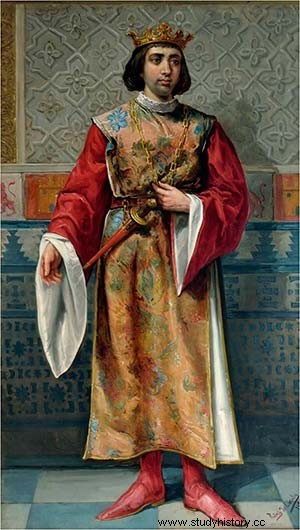After the death of Juan II, the new King of Castile was Enrique IV (1454-1474), known as the Impotent. Enrique IV, defined by Gregorio Marañón as dysplastic eunuchoid , is one of the most controversial monarchs in the entire history of Castile. Undoubtedly, weakness of character, withdrawal and apathy were typical of this monarch. The beginnings of reign, were positive. The economic situation of the Royal Treasury was favourable, due to the fact that the income of the Military Orders of Santiago and Alcántara had been assigned to the crown in its first years of reign. , which were vacant. Shortly after, Enrique IV decided to launch a war of attrition against the Nasrids, which did not please the nobility. In the Courts of Toledo in 1462 it was decided to reserve a third of the wool of the Crown of Castile for the textile production of its kingdoms, which annoyed the exporters of that product. The good image that Henry IV had at that time explains why the Catalans, rebels against their monarch Juan II, the former "infante de Aragón", offered him the principality. But the indecision of the King of Castile and the cunning intervention of Louis XI of France led Henry IV to abandon the Catalans' proposal.

The farce of Ávila
Gradually the opposition to Enrique IV grew from a good part of the high nobility. The most critical moment took place in the year 1465. In the month of June of that year, a grotesque ceremony was held on the outskirts of the city of Ávila, the so-called «farce of Ávila», in which the king, represented by a doll covered in mourning and placed on a chair, was stripped of the throne. Among the participants in that act were, among others, Juan Pacheco, who had been years ago the main collaborator of the King of Castile, and the Archbishop of Toledo, Alfonso Carrillo. The rebels proclaimed King of Castile a young brother of Enrique IV, the infante Alfonso, the hypothetical Alfonso XII. Despite everything, Enrique IV, with the support of the cities and some nobles who remained faithful to his cause, such as the Mendozas, defeated the rebels in the battle of Olmedo , in the year 1467. But his indecision prevented him, once again, from taking advantage of that triumph.
Death and succession of Henry IV

In 1468 the young Alfonso died of the plague. Enrique IV had had, from his second wife, Juana de Portugal, a daughter, also called Juana. Gossips attributed paternity to his new favourite, Beltrán de la Cueva, from which the name Juana la Beltraneja comes. Enrique IV, in the pact of the Toros de Guisando, of the year 1468, designated his sister Isabel as his successor. This was due not to his questionable paternity of the young Infanta Juana, but to the fact that her second marriage raised serious doubts of legality. However, the marriage of Isabel, in 1469, with the heir to the Crown of Aragon, Fernando, carried out without prior consultation with the King of Castile, as had been agreed, upset Enrique IV, who declared heir to the throne to his daughter Joan. An extremely confusing stage then began, which explains why, following the death of Enrique IV, an event that took place in 1474, Castile was the scene of a war of succession between the two candidates :Elizabeth, the sister of the deceased king, and Juana, his daughter.
